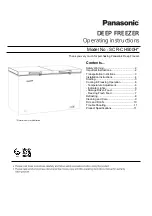
4
SUMMIT APPLIANCE
LOCATION REQUIREMENTS
Explosion Hazard
Keep flammable materials and vapors, such as gasoline, away
from freezer.
Failure to do so can result in death, explosion, or fire.
IMPORTANT: Do not install the freezer near an oven, radiator, or
other heat source, nor in a location where the temperature will fall
below 40°F (5°C).
Check the strength of the floor before installing your freezer. It
should hold the weight of a fully loaded freezer. Allow at least 3” (7.5
cm) of airspace at the top and on both sides of the freezer and 1” (2.5
cm) between the back of the freezer and the wall. If the freezer is
going to be placed against a wall, leave extra space on the hinge
side so the door can open wider than its width.
NOTE: This freezer may be installed side by side with another freezer
or refrigerator. Allow for a 3’ (7.5 cm) clearance at the top and sides
and a ¼” (0.64 cm) clearance between the appliances.
Electrical Shock Hazard
Plug into a grounded 3 prong outlet.
Do not remove ground prong.
Do not use an adapter.
Do not use an extension cord.
Failure to follow these instructions can result in death, fire, or
electrical shock.
Recommended grounding method
A 115 Volt, 60 Hz. AC only 15- or 20- amp fused or circuit breaker,
grounded electrical supply is required. It is recommended that a
separate circuit serving only your freezer be provided. Use outlets
that cannot be turned off by a switch or pull chain. Do not use an
extension cord.
9
•
Is the power supply cord unplugged?
Plug into a grounded 3
prong outlet.
• Is a light bulb loose in the socket or burned out?
See “Changing
the Light Bulb.”
The motor seems to run too much
• Is there something preventing the door from closing?
Move the
package so the door closes properly.
• Is the room temperature hotter than normal?
The motor will run
longer under warm conditions. At normal room temperatures, your
motor will run about 40% to 80% of the time. Under warmer condi-
tions, it will run even more.
•
Has a large amount of product just been added to the freezer?
Adding a large amount of product warms the freezer. The motor nor-
mally will run longer to cool the freezer back down.
• Is the door opened often?
The motor will run longer when this oc-
curs. Conserve energy by getting all items out at one time, and clos-
ing the door as soon as possible.
• Is the control set correctly for the surrounding conditions?
See
“Using the Control.”
• Is the door or not closed completely?
Push the door firmly shut. If
it will not shut all the way, see “The door will not close completely”
later in this section.
• Are the condenser coils dirty (on some models)?
This prevents
air transfer and makes the motor work harder. Clean the condenser
coils. See “Freezer Care.”
• Is the door gasket sealed all the way around?
Contact a qualified
person or a technician.
• Is there enough air circulation space around the freezer?
See
“Location Requirements.”
NOTE:
If the problem is not due to any of the above, remember that
your new freezer will run longer than your old one due to its high-
efficiency motor.
Use nonflammable cleaner.
Failure to do so can result in death, explosion, or fire.
SUMMIT APPLIANCE
























